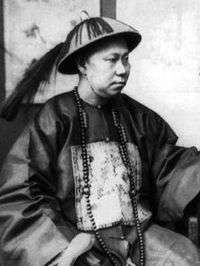Shen Baozhen
| Shen Baozhen | |
|---|---|
 | |
| Viceroy of Liangjiang | |
|
In office 1875–1879 | |
| Preceded by | Liu Kunyi |
| Succeeded by | Liu Kunyi |
| Personal details | |
| Born |
1820 Minhou, Fuzhou, Fujian |
| Died | 1879 |
| Occupation | Politician |
Shen Baozhen or Shen Pao-chen (Chinese: 沈葆禎; pinyin: Shěn Bǎozhēn; Pe̍h-ōe-jī: Sím Pó-cheng; 1820–1879) was an official during the Qing dynasty.
Biography
Born in Minhou in Fujian province, he obtained the highest degree in the imperial examinations in 1847 and was soon appointed to the Hanlin Academy.
His great administrative abilities attracted the attention of Zeng Guofan, who enlisted him in the effort to suppress the Taiping Rebellion.
Following the suppression of the rebellion in 1864, Shen became actively involved in the Self-strengthening movement and later worked on the shipyard in Fuzhou (Foochow). He utilized the skill of French technicians and workers – notably Prosper Giquel – to construct modern warships for the Imperial Navy prior to the destruction of the arsenal and the fleet itself during the Battle of Foochow in the 1883–1885 Sino-French War. Concurrently, he also improved the land tax collection system in Jiangxi province.[1]
He also took part in obtaining a peace settlement with Japan, following the Japanese Taiwan Expedition of 1874. Then he was appointed as the Viceroy of Liangjiang in 1875 and died in 1879 during the post. He is chiefly remembered for his belated opposition to the Woosung Road Company's railroad, which he purchased and dismantled in its first year of operation,[2] limiting Shanghai's development for twenty years.[n. 1]
Shen was married to Lin Puqing (林普晴, 1821–77), the third daughter of Lin Zexu. She exhibited great courage and determined tenacity when under siege by the Taiping rebels at Guangxin when she bandaged troops, cooked for them and cut her finger to write a message in blood.
Notes
- ↑ Shanghai remained unconnected to China's growing rail network until the line's reconstruction in 1898 and its subsequent extension to Nanjing in 1908.
References
- ↑ Wright, Mary C. The Last Stand of Chinese Conservatism: The T’ung-Chih Restoration, 1862-1874. (Stanford: Stanford University Press, 1962), 154.
- ↑ Huenemann, Ralph Wm. Harvard East Asian Monographs, Vol. 109. The Dragon and the Iron Horse: the Economics of Railroads in China, 1876–1937, pp. 2 ff. Harvard U. Asia Center, 1984. ISBN 0-674-21535-4. Accessed 14 Oct 2011.
- Hummel, Arthur William, ed. Eminent Chinese of the Ch'ing Period (1644–1912). 2 vols. Washington: United States Government Printing Office, 1943.
- Pong, David. Shen Pao-Chen and China's Modernization in the Nineteenth Century. Cambridge and New York: Cambridge University Press, 1994.
- Shen, Richard. 'The Yellow Riding Jacket' Xlibris, 2008
| Government offices | ||
|---|---|---|
| Preceded by Liu Kunyi |
Viceroy of Liangjiang 1875–1879 |
Succeeded by Liu Kunyi |